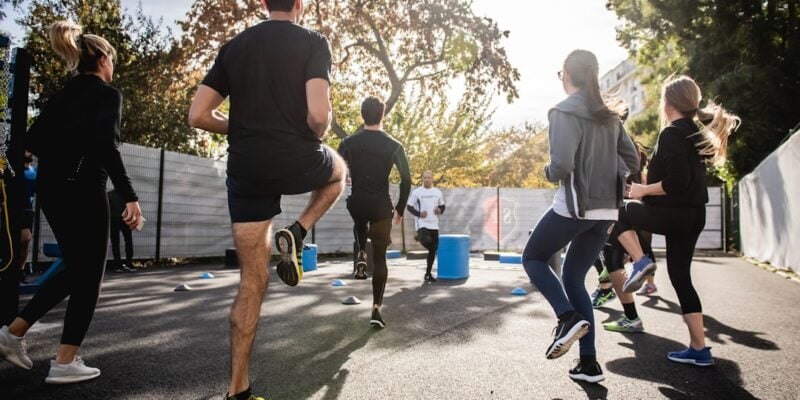
10 Simple Exercises to Boost Your Physical and Mental Health
Exercise is an essential component of a healthy lifestyle. It not only helps maintain physical fitness but also has numerous benefits for mental health. Regular exercise has been proven to reduce the risk of chronic diseases, improve cardiovascular health, and aid in weight management. Additionally, exercise has been shown to boost mood, reduce symptoms of depression and anxiety, and alleviate stress. In this article, we will explore the various benefits of exercise for both physical and mental health and provide tips and strategies for incorporating exercise into your daily routine.
Key Takeaways
- Exercise is crucial for both physical and mental health.
- Regular exercise can improve cardiovascular health, reduce stress and anxiety, and boost mood.
- Physical activity can help reduce stress and anxiety levels.
- Simple exercises like stretching, cardiovascular exercises, and strength training can improve physical health and fitness.
- Incorporating exercise into your daily routine can be achieved with simple tips and strategies.
The Benefits of Regular Exercise: A Comprehensive Overview
Regular exercise offers a wide range of benefits for overall health. One of the most well-known benefits is weight management. Engaging in physical activity helps burn calories, which can aid in weight loss or maintenance. Exercise also helps improve cardiovascular health by strengthening the heart and improving blood circulation. This can reduce the risk of heart disease, stroke, and high blood pressure.
Furthermore, regular exercise has been shown to reduce the risk of chronic diseases such as type 2 diabetes, certain types of cancer, and osteoporosis. Studies have consistently shown that individuals who engage in regular physical activity have a lower risk of developing these conditions compared to those who lead sedentary lifestyles.
Exercise and Mental Health: How Physical Activity Can Boost Your Mood
Exercise has a profound impact on mental health. Physical activity stimulates the release of endorphins, which are chemicals in the brain that act as natural painkillers and mood elevators. This can result in an immediate mood boost after exercise.
In addition to the immediate effects, regular exercise has been shown to have long-term benefits for mental health. Studies have found that individuals who engage in regular physical activity are less likely to experience symptoms of depression and anxiety. Exercise can also help improve self-esteem and body image, which are important factors in mental well-being.
The Role of Exercise in Reducing Stress and Anxiety
| Metrics | Findings |
|---|---|
| Stress Reduction | Regular exercise can reduce stress levels by releasing endorphins, improving mood, and reducing muscle tension. |
| Anxiety Reduction | Exercise can reduce symptoms of anxiety by increasing self-esteem, improving sleep quality, and providing a distraction from worries. |
| Types of Exercise | Aerobic exercise, such as running or cycling, and mind-body exercises, such as yoga or tai chi, have been found to be effective in reducing stress and anxiety. |
| Frequency and Duration | Regular exercise, at least 3-5 times per week for 30-60 minutes, is recommended for optimal stress and anxiety reduction. |
| Individual Differences | Individuals may respond differently to exercise in terms of stress and anxiety reduction, and it is important to find the type, frequency, and duration of exercise that works best for each person. |
Exercise is a powerful tool for reducing stress and anxiety. When we engage in physical activity, our bodies release stress hormones such as cortisol. However, regular exercise helps regulate these hormones and reduces their levels in the body. This can lead to a decrease in stress and anxiety.
Exercise also affects the brain in a way that reduces stress. Physical activity increases the production of endorphins, which are natural mood enhancers. These endorphins help counteract the negative effects of stress on the body and mind.
To incorporate exercise into a stress-reducing routine, it is important to find activities that you enjoy. This could be anything from walking or jogging to yoga or dancing. The key is to choose activities that you find enjoyable and that help you relax.
Top 10 Simple Exercises for Improving Physical Health and Fitness
1. Walking: Walking is a simple yet effective exercise that can be done anywhere. Aim for at least 30 minutes of brisk walking each day to improve cardiovascular health and burn calories.
2. Jogging: If you’re looking for a more intense workout, jogging is a great option. Start with short intervals of jogging and walking, gradually increasing the duration of your jogging intervals.
3. Cycling: Cycling is a low-impact exercise that can be done outdoors or on a stationary bike. It helps improve cardiovascular fitness and strengthens the leg muscles.
4. Swimming: Swimming is a full-body workout that is gentle on the joints. It improves cardiovascular health, builds muscle strength, and increases flexibility.
5. Jumping rope: Jumping rope is a fun and effective exercise that burns calories and improves cardiovascular fitness. It also helps improve coordination and agility.
6. Bodyweight exercises: Exercises such as push-ups, squats, lunges, and planks can be done anywhere without any equipment. They help build strength and improve muscle tone.
7. Yoga: Yoga combines physical postures, breathing exercises, and meditation to improve flexibility, strength, and mental well-being. It is a great exercise for reducing stress and anxiety.
8. Pilates: Pilates focuses on core strength, flexibility, and body awareness. It helps improve posture, balance, and muscle tone.
9. HIIT workouts: High-intensity interval training (HIIT) involves short bursts of intense exercise followed by periods of rest. It is a time-efficient way to burn calories and improve cardiovascular fitness.
10. Dancing: Dancing is a fun and enjoyable way to get moving. It improves cardiovascular health, coordination, and flexibility.
How to Incorporate Exercise into Your Daily Routine: Tips and Strategies
Incorporating exercise into your daily routine can be challenging, but with the right strategies, it can become a habit. Here are some tips to help you get started:
1. Set realistic goals: Start small and gradually increase the duration and intensity of your workouts. Setting realistic goals will help you stay motivated and avoid burnout.
2. Find activities you enjoy: Choose activities that you find enjoyable so that you are more likely to stick with them. This could be anything from dancing to hiking to playing a sport.
3. Schedule exercise into your day: Treat exercise like any other appointment and schedule it into your day. This will help ensure that you make time for it and prioritize your health.
4. Make it a social activity: Exercise with a friend or join a group fitness class. Exercising with others can make it more enjoyable and help keep you accountable.
5. Be flexible: If you can’t fit in a full workout, try to incorporate physical activity into your day in other ways. Take the stairs instead of the elevator, walk or bike to work, or do short bursts of exercise throughout the day.
The Importance of Stretching: Simple Stretches to Improve Flexibility and Mobility
Stretching is often overlooked but is an important component of a well-rounded exercise routine. Stretching helps improve flexibility, mobility, and posture. It also helps prevent injuries and muscle imbalances.
Here are some simple stretches that can be done to improve flexibility and mobility:
1. Hamstring stretch: Sit on the floor with one leg extended in front of you and the other leg bent. Reach forward and try to touch your toes, feeling a stretch in the back of your leg. Hold for 30 seconds and repeat on the other side.
2. Quadriceps stretch: Stand tall and grab one foot behind you, pulling it towards your glutes. Keep your knees close together and feel a stretch in the front of your thigh. Hold for 30 seconds and repeat on the other side.
3. Chest stretch: Stand tall with your feet shoulder-width apart. Interlace your fingers behind your back and squeeze your shoulder blades together, feeling a stretch in your chest. Hold for 30 seconds.
4. Shoulder stretch: Stand tall with your feet shoulder-width apart. Extend one arm across your chest and use the other arm to pull it closer to your body, feeling a stretch in your shoulder. Hold for 30 seconds and repeat on the other side.
5. Calf stretch: Stand facing a wall with one foot in front of the other. Lean forward, placing your hands on the wall, and keep your back leg straight with the heel on the ground. Feel a stretch in your calf muscle. Hold for 30 seconds and repeat on the other side.
How to Build Endurance and Stamina with Cardiovascular Exercises
Cardiovascular exercises are essential for building endurance and stamina. These exercises increase heart rate, improve lung capacity, and strengthen the cardiovascular system.
To build endurance and stamina, it is important to gradually increase the duration and intensity of your workouts. Start with shorter workouts and gradually increase the duration by a few minutes each week. As your fitness level improves, you can also increase the intensity by incorporating intervals of higher intensity exercise.
Some examples of cardiovascular exercises that can help build endurance and stamina include:
1. Running: Running is a high-impact exercise that can be done outdoors or on a treadmill. Start with shorter runs and gradually increase the distance and pace.
2. Cycling: Cycling is a low-impact exercise that can be done outdoors or on a stationary bike. Start with shorter rides and gradually increase the duration and intensity.
3. Swimming: Swimming is a full-body workout that is gentle on the joints. Start with shorter swims and gradually increase the distance and intensity.
4. HIIT workouts: High-intensity interval training (HIIT) involves short bursts of intense exercise followed by periods of rest. This type of workout is effective for building endurance and stamina.
The Benefits of Strength Training: Simple Exercises to Build Muscle and Bone Density
Strength training is an important component of a well-rounded exercise routine. It helps build muscle strength, improve bone density, and increase metabolism.
Some benefits of strength training include:
1. Increased muscle strength: Strength training helps build muscle strength, which can improve overall physical performance and reduce the risk of injury.
2. Improved bone density: Strength training helps improve bone density, which is important for preventing osteoporosis and reducing the risk of fractures.
3. Increased metabolism: Strength training increases muscle mass, which in turn increases metabolism. This can help with weight management and maintaining a healthy body composition.
4. Enhanced functional fitness: Strength training improves functional fitness, which is the ability to perform everyday activities with ease. This can improve quality of life and independence as we age.
Some simple strength training exercises that can be done at home or with minimal equipment include:
1. Squats: Stand with your feet shoulder-width apart and lower your body as if you are sitting back into a chair. Keep your knees behind your toes and your chest lifted. Push through your heels to return to the starting position.
2. Push-ups: Start in a high plank position with your hands slightly wider than shoulder-width apart. Lower your body until your chest touches the ground, then push back up to the starting position.
3. Lunges: Stand with your feet hip-width apart and take a step forward with one foot. Lower your body until both knees are bent at a 90-degree angle, then push through your front heel to return to the starting position. Repeat on the other side.
4. Plank: Start in a high plank position with your hands directly under your shoulders and your body in a straight line from head to toe. Hold this position for as long as you can while maintaining proper form.
Making Exercise a Habit for Better Physical and Mental Health
In conclusion, exercise is crucial for both physical and mental health. Regular physical activity has numerous benefits, including weight management, improved cardiovascular health, reduced risk of chronic diseases, and enhanced mental well-being. Exercise has been shown to boost mood, reduce symptoms of depression and anxiety, and alleviate stress.
To incorporate exercise into your daily routine, it is important to set realistic goals, find activities you enjoy, schedule exercise into your day, make it a social activity, and be flexible. Additionally, stretching, cardiovascular exercises, and strength training are all important components of a well-rounded exercise routine.
By making exercise a habit, you can improve both your physical and mental health and enjoy the many benefits that regular physical activity has to offer. So lace up those sneakers, grab a friend, and start moving towards a healthier and happier you!
Looking for a unique way to enhance your exercise routine? Check out Wave Magnets, a revolutionary fitness tool that combines the power of magnetic therapy with physical activity. This innovative device helps improve blood circulation, reduce muscle soreness, and increase energy levels during workouts. If you want to learn more about the benefits of incorporating magnetic therapy into your exercise regimen, be sure to read this informative article on Wave Magnets’ website: The Science Behind Magnetic Therapy and Exercise. Discover how this cutting-edge technology can take your fitness journey to the next level.
FAQs
What is exercise?
Exercise is any physical activity that is planned, structured, and repetitive for the purpose of improving or maintaining one or more components of physical fitness.
What are the benefits of exercise?
Exercise has numerous benefits, including improving cardiovascular health, reducing the risk of chronic diseases such as diabetes and obesity, improving mental health and cognitive function, and increasing overall physical fitness and strength.
How much exercise should I do?
The American Heart Association recommends at least 150 minutes of moderate-intensity aerobic exercise or 75 minutes of vigorous-intensity aerobic exercise per week, along with muscle-strengthening activities at least two days per week.
What are some examples of aerobic exercise?
Examples of aerobic exercise include brisk walking, running, cycling, swimming, and dancing.
What are some examples of muscle-strengthening exercises?
Examples of muscle-strengthening exercises include weightlifting, resistance band exercises, push-ups, and squats.
What should I wear when exercising?
It is important to wear comfortable, breathable clothing and supportive shoes when exercising. Clothing should allow for a full range of motion and should be appropriate for the type of exercise being performed.
Is it safe to exercise if I have a medical condition?
It is important to consult with a healthcare provider before starting an exercise program if you have a medical condition. Your healthcare provider can help you determine what types of exercise are safe and appropriate for you.


















